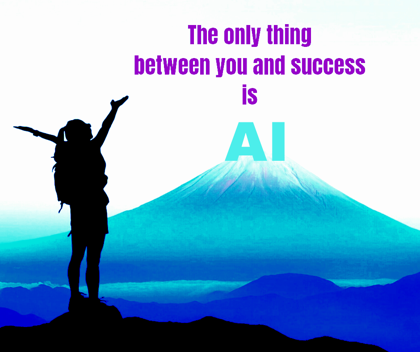


Uncertain times block our view of the future, making it seem like clouds lurk on the horizon. This phenomenon has affected the rapid emergence of artificial intelligence.
Worries get more headlines than optimism. Yet if you stand back, AI is fast becoming the greatest ally the human mind has had in modern times.
It’s worthwhile to map the breakthroughs that aren’t simply possible but almost certain to emerge.
In every field that has been moving steadily toward a breakthrough that will benefit everyone’s life, the pace of progress is sure to accelerate.
Nine breakthrough stand out as the most important.
1. AI itself
A decade ago artificial intelligence was a fringe project with science-fiction overtones. Yet the whole field suddenly reached a tipping point. This happened by discovering that certain basic processes in the human brain could be digitized. The brain at its most complex still remains far and away the only true source of intelligence and creativity, but with supercomputers, it is possible to mimic three things everyone relies upon in daily life: memory, self-learning, and focused information gathering. The next breakthroughs will come even closer to doing on a computer more and better mimicry of brain processes. Look for AI that imitates sentience (self-awareness), which will lead to an astonishing illusion that a machine has a mind.
2. Microbiome
Most people have now heard of the microbiome, the collected bacteria and other micro-organisms that enable us to digest food. The discovery that thousands of species of bacteria are involved, as well as mapping their genes, is sometimes considered the greatest biological discovery since mapping the human genome twenty years ago. Now it is realized that gut health is entangled with a person’s total well-being.
This has given rise to a growing focus on prebiotics to boost a balanced microbiome. Yet everyone’s microbiome is individualized and dynamic—constant changes occur on a daily basis, and the complexity of an immense bacterial colony needs a breakthrough that AI can provide. Through supercomputing, analyzing your microbiome and recommending exactly the right foods and supplements to optimize its health will be a huge breakthrough in well-being.
3. CRISPR and gene editing
Like human beings, bacteria are regularly attacked by viruses, and like us, an immune response is needed to ward off future infection. Bacteria evolved to use fragments of DNA known as CRISPR that are inserted into the strand of DNA to defeat future attacks by the same viruses. In effect, bacteria edit their own genes. This astonishing discovery led to an explosion of uses for gene editing applied to everything where immunity might be boosted, from infection-resistant yogurt to infection-resistant field crops.
One can look ahead to any application where gene editing might prevent disease, or correct genetic mistakes—in essence by creating designer genes.
CRISPR has potentially billions of applications given the complexity of human DNA, and the supercomputing power of AI is perfectly suited to analyze, forecast, and discover new CRISPR applications hundreds and thousands of times faster than traditional research techniques. Super-immunity could be just around the corner.
4. Messenger RNA technology
In 2020 the dire emergency of the global COVID pandemic called for the quickest development of a vaccine in medical history. What made this kind of acceleration possible was a new approach to vaccines that centered on messenger RNA (mRNA). Messenger RNA is the active twin of DNA. As the name indicates, it carries genetic information to a cell, governing the formation of thousands of proteins that make the cell’s life possible. An mRNA vaccine takes a protein that identifies a virus, usually on the virus’ outer membrane, and allows your cells to duplicate it. Thus tagged, this protein gives antibodies the power to quickly identify the invading virus and mark it for destruction. The success of mRNA vaccines for COVID marked the beginning of a new era. There is the potential to develop mRNA vaccines for many other disorders, including cancer. The vision of a universal vaccine is in the air. But millions of proteins exist in nature, and with AI’s supercomputing power, huge numbers of these have already been mapped thousands of times faster than a human researcher.
The potential for future mRNA technologies seems vast.
5. Psychedelics
There has been extensive media coverage about the sudden rise to respectability of hallucinogenic drugs. Although still illegal for general use, psychedelics are coming into their own medically, especially in psychotherapy. Ancient cultures preceded us in respecting, even revering, the power of naturally occurring hallucinogens, which strongly break through the brain’s accustomed worldview.
In essence, if you can alter brain chemistry in radical ways, reality shifts as experienced by the mind. The point isn’t merely recreational tripping. Novel realities can improve upon stuck viewpoints ingrained in brain processes, including anxiety, depression, and PTSD. Looking even further, novel realities might have sacred and spiritual importance, just as ancient cultures discovered. Given the complexity of brain chemistry, a great deal more needs to be known about the interaction of psychedelics at the molecular level.
This is yet another aspect of AI’s super computation that promises a breakthrough in how each of us sees the world, including better ways to change the stuckness of mental disorders.
6. Epigenetics
It is obvious from everyday experience that you respond to the world in countless ways.
You can’t have any experience, however, without your cells getting involved.
Your body is a superhighway of chemical signals that mediate you and your biology.
Key to this is the outer covering of DNA known as the epigene. DNA doesn’t simply sleep in the nucleus of every cell.
It is active, and how this activity is switched on and off, along with how high the activity is, depends on the epigene. Experiences chemically mark the epigene—that much is clear—but the intricacy of human experience is nearly infinite. Anything that has strongly affected you in the past, and the past of your family line, has been recorded and stored in the epigene. This opens a huge potential for altering the markers that are associated with disease, bad habits, old conditioning, traumatic memories, and defective cellular processes.
AI could step in to map the epigene with incredible speed. If this technology became personalized, you could see your epigene decoded and printed out for you or your doctor in a matter of minutes.
7. Neuroplasticity and brain decoding
Without much public awareness, some fundamental assumptions about the human brain have been overturned.
The two most important were the notion that we are born with a set complement of brain cells that last a lifetime and the notion that the brain cannot repair itself.
In reality brain cells can be renewed through stem cells, the brain has strong healing powers, and new connections between neurons are formed throughout our lifetime.
This shift to a dynamic picture is classified as neuroplasticity. Yet little is really understood about why some brains heal and renew while others don’t.
This leaves a fertile field for collecting massive data about how each brain operates, which it takes AI to gather in such huge amounts. In addition, it turns out that the thoughts we experience as words and feelings are correlated with neural signals that can actually be read and manipulated.
In effect, with precise enough decoding, a person’s mind can be read.
AI could be a powerful tool for insight into someone’s habitual thought and behavior patterns, which could be of enormous benefit in psychotherapy.
8. Vagal activation
It has long been known that the brain communicates to the rest of the body via the central nervous system, but only in recent years has it been realized that one of the ten nerves that leads from the brain, the vagus nerve, holds tremendous healing potential.
The vagus nerve plays a major role in connecting and balancing the core signals of breathing and heartrate as well as the activity of the gastrointestinal system.
Simple breathing techniques known as vagal breathing, have shown themselves to be powerful reducers of stress. But vagal activation and stimulation can go much farther.
Much depends on discovering how the intricate superhighway of information flowing through the central nervous system “speaks” in ways we can understand as a neural language, another path for AI to explore.
9. Creative intelligence
Although it is only now being recognized in the West, the system of Yoga mapped out an ideal life according to eight departments, or limbs, that address how consciousness works.
The common feature in this vast body of knowledge is Shakti, or creative intelligence.
The highest values in human life—love, compassion, empathy insight, inner growth, spiritual values, and creativity itself—were not invented by the brain.
According to Yoga, they are our birthright, which is why they appear in every advanced culture in various forms. Creative intelligence flows through us silently and invisibly to enliven mind and body, always aiming to make us more fully human.
Yet modern secular society has barely delved into how consciousness, as opposed to the brain, actually operates, by what lows or principles it organizes everything about us (and about the cosmos, according to Yoga).
AI could offer a breakthrough here by gathering everything known about Shakti in the world’s wisdom traditions and putting it at our fingertips.
This sketch is only a start, because AI can go wherever our minds go.
It mimics not just the human brain but certain aspects of consciousness, such as self-learning.
What I’ve outlined here has focused on another aspect of consciousness: curiosity and discovery. But taken broadly, the import of AI is the consciousness now has a powerful ally in expanding and evolving human awareness, as nothing in the past has done so efficiently.
*******
DEEPAK CHOPRA MD, FACP, FRCP, founder of The Chopra Foundation, a non-profit entity for research on well-being and humanitarianism, and Chopra Global, a whole health company at the intersection of science and spirituality, is a world-renowned pioneer in integrative medicine and personal transformation. Chopra is a Clinical Professor of Family Medicine and Public Health at the University of California, San Diego and serves as a senior scientist with Gallup Organization. He is the author of over 90 books translated into over forty-three languages, including numerous New York Times bestsellers. His 91st book, Total Meditation: Practices in Living the Awakened Life explores and reinterprets the physical, mental, emotional, relational, and spiritual benefits that the practice of meditation can bring. For the last thirty years, Chopra has been at the forefront of the meditation revolution. His latest book, Living in the Light co-authored with Sarah Platt-Finger. TIME magazine has described Dr. Chopra as “one of the top 100 heroes and icons of the century.” www.deepakchopra.com